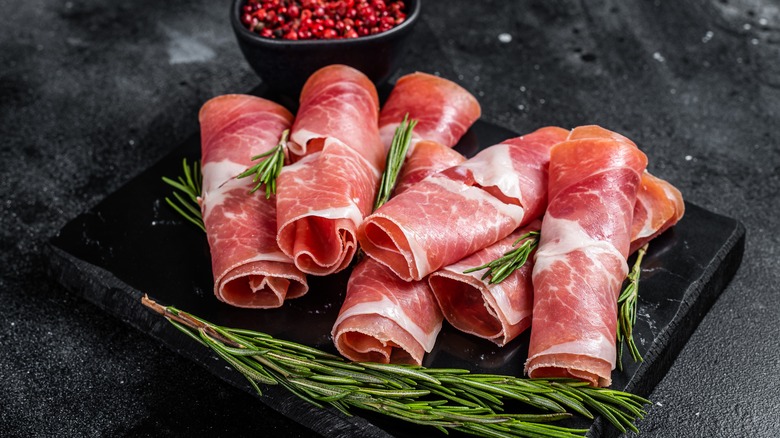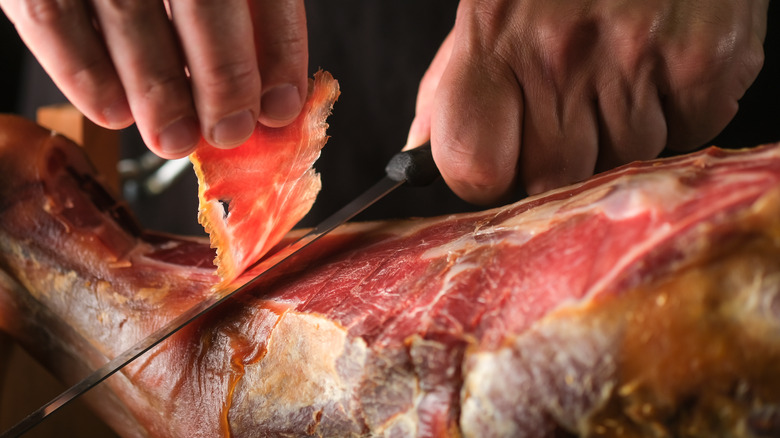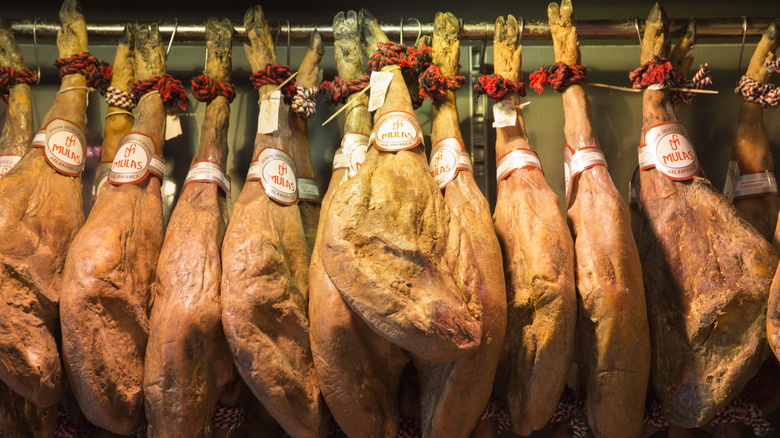The Difference Between Jamón Iberico And Jamón Serrano
If you've ever been fortunate enough to try jamón from Spain, you know what an absolute treat it is. A genuinely iconic Spanish staple — perhaps even more so than paella — jamón (ham) is beloved throughout the country and worldwide for its salty, melt-in-your-mouth goodness. While you are likely to find bites of it on a tapas menu or charcuterie board, some things we need to clear up are of the utmost importance. Ham is big business in Spain; the country produces 40 million hams annually, per Food & Wine.
If you've never had this Spanish meat, you should know that it's nothing like the ham you find in the United States. Perhaps the closest relative would be Italian prosciutto, but it's even different from that when it comes to taste — and cost. You are likely to see two kinds: jamón iberico and jamón serrano. While both types are delicious, they are pretty different, and the distinction is crucial.
Jamón serrano
Jamón serrano has nothing to do with serrano pepper, despite its name. It's actually a cured country ham made from pork that is covered in salt and cured by aging it for up to 18 months, per Jamon.com. Once it's cured, the ham can be shaved into thin pieces, similar to prosciutto, and added to several delicious Spanish dishes or eaten on its own.
Jamón serrano is Spain's most readily available jamón, making up 90% of its ham production. Jamón serrano comes from a specific type of pig: white pigs, namely Duroc (prized for pork chops as well), Pietrain, or Landrace, among others. These pigs are fed a grain-based diet. Compared to other popular European hams like prosciutto, jamón serrano's final product is a very firm ham, deep red in color with some fat marbling and a very authentic ham taste, per Jamon.com.
Jamón ibérico
Jamón ibérico is a rare gem in Spanish ham, thanks to its unique texture and flavor and the prized bloodline of the pigs that produce it. What Kobe is to beef, ibérico is to ham. It comes from one particular type of pig: the black ibérico pig. These pigs — which originate from the Iberian Peninsula from the time of the Phoenicians — continue to roam free, feeding on a rich diet of acorns (bellotas in Spanish), per Spanish Sabores. The acorns help quickly fatten the pig, but in a pretty healthy way. The fat that forms on these pigs from their diet is mono-unsaturated fat — according to Jamon.com — the same stuff in olive oil. The pigs have been referred to as "walking olive oil" because of their healthy fat makeup.
Jamón ibérico makes up less than 10% of the Spanish ham market, according to Jamon.com. The meat is cured for 24-to-48 months, and much of the fat dissolves during this time. The result is a beautifully marbled ham with a decadent, quality ham flavor that can sell for up to thousands of euros per leg.


